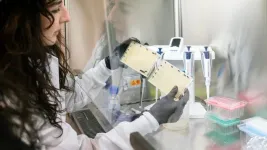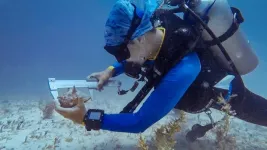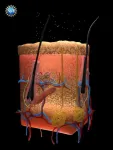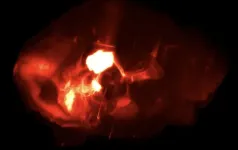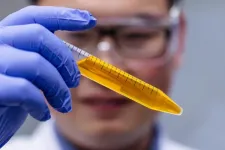(Press-News.org) Seeing what’s going on inside a body is never easy. While technologies like CT scans, X-rays, MRIs, and microscopy can provide insights, the images are rarely completely clear and can come with side effects like radiation exposure.
But what if you could apply a substance on the skin, much like a moisturizing cream, and make it transparent, without harming the tissue?
That’s what Stanford scientists have done using an FDA-approved dye that is commonly found in food, among several other light-absorbing molecules that exhibit similar effects. Published in Science on Sept. 5, the research details how rubbing a dye solution on the skin of a mouse in a lab allowed researchers to see, with the naked eye, through the skin to the internal organs, without making an incision. And, just as easily as the transparency happened, it could be reversed.
“As soon as we rinsed and massaged the skin with water, the effect was reversed within minutes,” said Guosong Hong, assistant professor of materials science and engineering and senior author on the paper. “It’s a stunning result.”
Absorption reduces scattering of light
When light waves strike the skin, the tissue scatters them, making it appear opaque and non-transparent to the eye. This scattering effect arises from the difference in the refractive indices of different tissue components, such as water and lipids. Water usually has a much lower refractive index than lipids in the visible spectrum, causing visible light to scatter as it goes through tissue containing both.
To match the refractive indices of different tissue components, the team massaged a solution of red tartrazine – also known as the food dye FD&C Yellow 5 – onto the abdomen, scalp, and hindlimb of a sedated mouse. The skin turned red in color, indicating that much of the blue light had been absorbed due to the presence of this light-absorbing molecule. This increase in absorption altered the refractive index of the water at a different wavelength – in this case, red. As a result of the absorption of the dye, the refractive index of water matches that of lipids in the red spectrum, leading to reduced scattering and making the skin appear more transparent at the red wavelength.
This research is a new application of decades-old equations that can describe the relationship between absorption and refractive index, called the Kramers-Kronig relations. In addition to this food dye, several other light-absorbing molecules have demonstrated similar effects, thereby confirming the generalizability of the underlying physics behind this phenomenon.
Researchers were able to see, without special equipment, the functioning internal organs, including the liver, small intestine, cecum, and bladder. They were also able to visualize blood flow in the brain and the fine structures of muscle fibers in the limb. The mouse’s beating heart and active respiratory system indicated that transparency was successfully achieved in live animals. Furthermore, the dye didn’t permanently alter the subject’s skin, and the transparency disappeared as soon as the dye was rinsed with water.
The researchers believe this is the first non-invasive approach to achieving visibility of a mouse’s living internal organs.
“Stanford is the perfect place for such a multifaceted project that brings together experts in materials science, neuroscience, biology, applied physics, and optics,” said Mark Brongersma, professor of materials science and engineering and co-author on the paper. “Each discipline comes with its own language. Guosong and I enjoyed taking each other’s courses on neuroscience and nanophotonics to better appreciate all the exciting opportunities.”
The potential future of ‘clear’ tissue
Right now, the study has only been conducted on an animal. If the same technique could be translated to humans, it could provide a range of biological, diagnostic, and even cosmetic benefits, Hong said.
For example, instead of through invasive biopsies, melanoma testing could be done by looking directly at a person’s tissue without removing it. This approach could potentially also replace some X-rays and CT scans, and make blood draws less painful by helping phlebotomists easily find veins. It could also improve services like laser tattoo removal by helping to focus laser beams precisely where the pigment is below the skin.
“This could have an impact on health care and prevent people from undergoing invasive kinds of testing,” said Hong. “If we could just look at what’s going on under the skin instead of cutting into it, or using radiation to get a less than clear look, we could change the way we see the human body.”
Other Stanford co-authors include Betty Cai, member of the Department of Materials Science Engineering; Zihao Ou, Carl H. C. Keck, Shan Jiang, Kenneth Brinson Jr, Su Zhao, Elizabeth L. Schmidt, Xiang Wu, Fan Yang, Han Cui, and Shifu Wu, who are also with the Department of Materials Science Engineering and Wu Tsai Neurosciences Institute; Yi-Shiou Duh of the Department of Physics and Geballe Laboratory for Advanced Materials; Nicholas J. Rommelfanger of the Wu Tsai Neurosciences Institute and Department of Applied Physics; Wei Qi and Xiaoke Chen of the Department of Biology; Adarsh Tantry of the Wu Tsai Neurosciences Institute and Neurosciences IDP Graduate program; Richard Roth of the Department of Neurosurgery; Jun Ding of the Department of Neurosurgery and Department of Neurology and Neurological Sciences; and Julia A. Kaltschmidt of the Wu Tsai Neurosciences Institute and Department of Neurosurgery.
This work was supported by the National Institutes of Health, National Science Foundation, Air Force, Beckman Technology, Rita Allen Foundation, Focused Ultrasound Foundation, Spinal Muscular Atrophy Foundation, Pinetops Foundation, Bio-X Initiative of Stanford University, Wu Tsai Neuroscience Institute, Knight-Hennessy, and U.S. Army Long Term Health Education and Training program.
Disclaimer: The technique described above has not been tested on humans. Dyes may be harmful. Always exercise caution when handling dyes – do not consume them, apply them to people or animals, or misuse them in any way.
END
Researchers make mouse skin transparent using a common food dye
2024-09-05
ELSE PRESS RELEASES FROM THIS DATE:
Groundwater use can be accurately monitored with satellites using OPENet, new study finds
2024-09-05
Drought is a widespread concern in the Western U.S., and water managers across the region are developing groundwater management plans to conserve the essential resource. Groundwater is often pumped to the surface to irrigate crops, and meters that measure the flow of pumped water have historically offered the best information on groundwater use. These meters are rare, however, so DRI scientists set out to determine whether OpenET, a platform that measures evapotranspiration using satellite data, could help fill this information gap.
The new study, published August 8th in a special issue of Agricultural Water Management, compared groundwater meter ...
New technology could lead to alternative treatments for antibiotic-resistant bacteria
2024-09-05
SAN FRANCISCO—As antibiotic resistance becomes an increasingly serious threat to our health, the scientific and medical communities are searching for new medicines to fight infections. Researchers at Gladstone Institutes have just moved closer to that goal with a novel technique for harnessing the power of bacteriophages.
Bacteriophages, or phages for short, are viruses that naturally take over and kill bacteria. Thousands of phages exist, but using them as treatments to fight specific bacteria has so far proven to be challenging. To optimize phage therapy and make it scalable to human disease, scientists need ways to engineer phages into efficient bacteria-killing machines. This would ...
Research shows queen conch populations in marine reserves replenish populations beyond the reserve in The Bahamas
2024-09-05
A new study published in Conservation Science and Practice uncovers how breeding populations of queen conch (Aliger gigas) within a protected marine reserve, where fishing is prohibited, sustain populations beyond the borders of the reserve. This research, based on surveys conducted in The Bahamas by Shedd Aquarium and Bahamian partners, identifies where additional protections could help to ensure the survival of future queen conch generations.
In The Bahamas, queen conch is an economic and cultural ...
Worcester Polytechnic Institute launches nation's first master’s program in explosion protection engineering
2024-09-05
Worcester, MA – September 5, 2024—Worcester Polytechnic Institute (WPI) has launched a groundbreaking Master of Science in Explosion Protection Engineering, the first program of its kind in the United States. Designed amid growing concerns about fire and explosion risk posed by manufacturing facilities and advancing technologies like electric vehicles and hydrogen fuel cells, the new program builds on WPI’s esteemed legacy in Fire Protection Engineering, which has been at the forefront of fire safety education and research since its inception in 1978.
“The demand ...
UC Irvine, USC scientists begin research effort for damaged brain region treatments
2024-09-05
Irvine, Calif., Sept. 5, 2024 — With newly awarded funding from the National Science Foundation, researchers at the University of California, Irvine and the Keck School of Medicine of USC will seek to revolutionize the treatment of neurological diseases through intelligent biocomputing. The four-year, $2 million grant is part of NSF’s Emerging Frontiers in Research and Innovation program, which funds cutting-edge science pushing the boundaries of human knowledge.
The premise of the UC Irvine-USC project is to combine engineering principles with stem cell research to treat damaged brain regions. The team’s long-term goal is to restore motor functions to patients ...
Risky combos of psychiatric drugs prescribed for young patients
2024-09-05
A new study reveals that young patients treated with psychiatric medications receive potentially dangerous combinations with concerning frequency.
Researchers from Rutgers Health and other institutions analyzed New York State Medicaid records for more than 141,000 patients receiving any psychiatric medication. Nearly 400 of them received at least one potentially dangerous combination t for one month or longer. Doctors refer to these as severe drug-drug interactions, and their use is typically considered "contraindicated" or recommended ...
A window into the body: groundbreaking technique makes skin invisible
2024-09-05
Images, animations, and video available in our NSF portal:
https://nsf.widencollective.com/portals/ematkiby/TheInvisibleMouseEmbargoed
Access Code: Le9ANH7tYTdr
Researchers have developed a new way to see organs within a body by rendering overlying tissues transparent to visible light.
The counterintuitive process—a topical application of food-safe dye—was reversible in tests with animal subjects, and may ultimately apply to a wide range of medical diagnostics, from locating injuries to monitoring digestive disorders to identifying cancers.
Stanford University researchers published the research ″Achieving optical ...
Serotonin to bounce back from adversity
2024-09-05
The simple act of observing others cope with a traumatic experience can increase our capacity for resilience and prevent the pathological states that can result from it, notably depression. Neuroscientists at UNIL have demonstrated the presence of this “emotional contagion” in mice, and successfully deciphered its mechanism. The neurotransmitter serotonin, released in a brain structure called the habenula, has been shown to be the key to resilience. This discovery, published in Science, revisits the role of serotonin ...
Yellow dye solution makes tissue transparent on living animals
2024-09-05
In a pioneering new study, researchers made the skin on the skulls and abdomens of live mice transparent by applying to the areas a mixture of water and a common yellow food coloring called tartrazine.
Dr. Zihao Ou, assistant professor of physics at The University of Texas at Dallas, is lead author of the study, published in the Sept. 6 print issue of the journal Science.
Living skin is a scattering medium. Like fog, it scatters light, which is why it cannot be seen through.
“We combined the yellow dye, which is a molecule that absorbs most light, ...
The collapse of bat populations led to more than a thousand infant deaths
2024-09-05
Bats are considered a natural pesticide, widely relied on by farmers as an alternative to chemical pesticides to protect their crops from insects. But since 2006, many bat populations have collapsed in counties in North America due to an invasive fungus found in the caves bats use during the day and throughout winter that causes what is known as White-Nose Syndrome. A new study in Science uses their sudden collapse to explore whether farmers turned to chemical pesticides, and whether doing so impacts human health. It finds that farmers did increase their pesticide use, leading to more than 1,000 infant deaths.
“Bats ...

